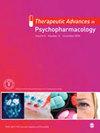氯氮平性低血压的治疗策略:系统综述
IF 3.4
3区 医学
Q2 PHARMACOLOGY & PHARMACY
引用次数: 5
摘要
背景:氯氮平是治疗难治性精神分裂症最有效的药物,但会产生显著的不良反应,包括低血压和头晕,这会对生活质量和治疗依从性产生负面影响。治疗氯氮平引起的低血压的现有证据不足。目的:由于对氯氮平诱导的低血压药物治疗的安全性和有效性的指导有限,我们开始系统地回顾和评估氯氮平诱导性低血压的治疗证据,并为临床医生、患者和护理人员提供指导。设计:在现有证据有限的情况下,我们对氯氮平引起的低血压干预措施的安全性和有效性进行了系统回顾。数据来源和方法:PubMed、Embase、PsycINFO、CINAHL和Cochrane试验注册中心从开始到2021年11月使用PROSPERO预先注册的搜索策略搜索氯氮平诱导的低血压和头晕的治疗策略的文献。对于直立性低血压,我们制定了一个管理框架来帮助选择干预措施。结果:我们确定了9个案例研究和4个案例系列,描述了15名患者的干预措施。降压干预措施包括暂时减少氯氮平剂量、非药物治疗和药物治疗。米多林、氟氢可的松、吗氯贝胺和Bovril®联合用药以及依替勒林与症状改善或直立性低血压减少有关。血管紧张素II、精氨酸加压素和去甲肾上腺素在重症监护情况下成功恢复并维持了平均动脉压。据报道,使用肾上腺素会出现严重低血压的反常反应。结论:体位性低血压是氯氮平滴定过程中常见的副作用。在对滴定时间表、盐和液体摄入进行评估,并对高血压和非选择性α1-肾上腺素能药物进行审查后,一线治疗应暂时减少氯氮平剂量或非药物干预。如果直立性低血压持续存在,应在监测钾水平、钠和液体摄入的情况下试验氟氢化可的松。米多林可被视为二线药物,或氟氢化可的松禁忌或耐受性差的药物。对于在重症监护环境中服用氯氮平并低血压的患者,应避免使用肾上腺素来维持平均动脉压。注册:PROSPERO(注册号CRD42020191530)本文章由计算机程序翻译,如有差异,请以英文原文为准。
Treatment strategies for clozapine-induced hypotension: a systematic review
Background: Clozapine is the most effective medication for treatment–refractory schizophrenia but is associated with significant adverse drug effects, including hypotension and dizziness, which have a negative impact on quality of life and treatment compliance. Available evidence for the management of clozapine-induced hypotension is scant. Objectives: Due to limited guidance on the safety and efficacy of pharmacological treatments for clozapine-induced hypotension, we set out to systematically review and assess the evidence for the management of clozapine-induced hypotension and provide guidance to clinicians, patients, and carers. Design: We undertook a systematic review of the safety and efficacy of interventions for clozapine-induced hypotension given the limited available evidence. Data Sources and Methods: PubMed, Embase, PsycINFO, CINAHL, and the Cochrane trial Registry were searched from inception to November 2021 for literature on the treatment strategies for clozapine-induced hypotension and dizziness using a PROSPERO pre-registered search strategy. For orthostatic hypotension, we developed a management framework to assist in the choice of intervention. Results: We identified nine case studies and four case series describing interventions in 15 patients. Hypotension interventions included temporary clozapine dose reduction, non-pharmacological treatments, and pharmacological treatments. Midodrine, fludrocortisone, moclobemide and Bovril® combination, and etilefrine were associated with improvement in symptoms or reduction in orthostatic hypotension. Angiotensin II, arginine vasopressin, and noradrenaline successfully restored and maintained mean arterial pressure in critical care situations. A paradoxical reaction of severe hypotension was reported with adrenaline use. Conclusion: Orthostatic hypotension is a common side effect during clozapine titration. Following an assessment of the titration schedule, salt and fluid intake, and review of hypertensive and nonselective α1-adrenergic agents, first-line treatment should be a temporary reduction in clozapine dose or non-pharmacological interventions. If orthostatic hypotension persists, fludrocortisone should be trialled with monitoring of potassium levels and sodium and fluid intake. Midodrine may be considered second-line or where fludrocortisone is contraindicated or poorly tolerated. For patients on clozapine with hypotension in critical care settings, the use of adrenaline to maintain mean arterial pressure should be avoided. Registration: PROSPERO (Registration No. CRD42020191530)
求助全文
通过发布文献求助,成功后即可免费获取论文全文。
去求助
来源期刊
CiteScore
7.90
自引率
2.40%
发文量
35
审稿时长
10 weeks
期刊介绍:
Therapeutic Advances in Psychopharmacology delivers the highest quality peer-reviewed articles, reviews, and scholarly comment on pioneering efforts and innovative studies across all areas of psychopharmacology. The journal has a strong clinical and pharmacological focus and is aimed at clinicians and researchers in psychopharmacology, providing a forum in print and online for publishing the highest quality articles in this area.

 求助内容:
求助内容: 应助结果提醒方式:
应助结果提醒方式:


